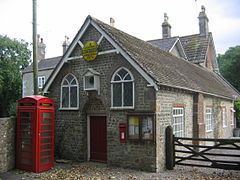Population 83 (in 2011) Civil parish Brixton Deverill Dialling code 01985 Post town Warminster | OS grid reference ST863388 Unitary authority | |
 | ||
Brixton Deverill is a small village and civil parish about 4 miles (6.4 km) south of Warminster in Wiltshire, England.
Contents
Map of Brixton Deverill, Warminster, UK
The parish is in the Deverill Valley which carries the upper waters of the River Wylye. The six villages of the valley - Kingston Deverill, Monkton Deverill, Brixton, Hill Deverill, Longbridge Deverill and Crockerton - are known as the Deverills.
Brixton Deverill appears in the Domesday Book.
Local government
The parish elects a joint parish council with neighbouring Kingston Deverill. The combined council is Upper Deverills Parish Council.
Brixton Deverill falls within the area of the Wiltshire Council unitary authority, which is responsible for all significant local government functions.
Church
The Anglican Church of St Michael the Archangel dates from the 13th century and has a 15th-century tower; restoration was carried out in 1730 and 1862. The font from St Giles, Imber, was relocated here following the evacuation of that village in 1943. In 1968 the church was designated as Grade II* listed.
Roman villa
In April 2016 it was announced that the remains of a large Roman villa had been discovered in the village in February 2015. After excavations by archaeologists from Historic England and The Salisbury Museum, a mosaic floor was uncovered of a large Roman property, similar in size and structure to the great Roman villa at Chedworth, Gloucestershire. Surviving sections of walls, 1.5 metres (4.9 ft) in height, have confirmed that the mosaic formed part of a grand villa, thought to have been three-storeys in height, its grounds extending over 100 metres (110 yd) in width and length.
Dr David Roberts, archaeologist for Historic England, said:
This site has not been touched since its collapse 1400 years ago and, as such, is of enormous importance. Without question, this is a hugely valuable site in terms of research, with incredible potential.
The discovery of such an elaborate and extraordinarily well-preserved villa, undamaged by agriculture for over 1500 years, is unparalleled in recent years. Overall, the excellent preservation, large scale and complexity of this site present a unique opportunity to understand Roman and post-Roman Britain.
The site is now known as the Deverill Villa after the name of the 17th-century house owned by Luke Irwin, who made the discovery. Irwin, a Dublin-born designer who makes hand-made silk, wool and cashmere rugs, found the remains in 2015 while laying electricity cables beneath a stretch of ground to the rear of his property. A Roman stone coffin, suitable for a child, which was being used as a plant pot, was also discovered.
